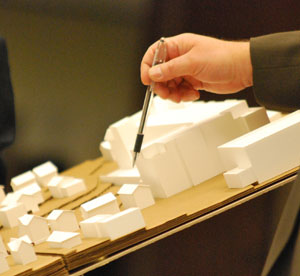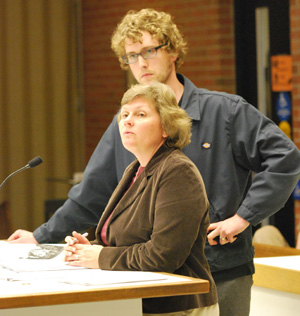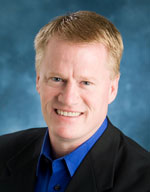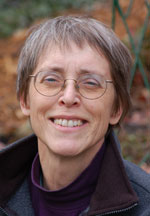5:00 p.m. Police car parked in the gravel lot. Red sedan takes the turn near Main Street with squealing brakes, spins out 360, over the curb, edge of the woods. Immediate police response. Impressive skid marks on the road.
Archive for April, 2010
Traver Road
3:49 p.m. Firetruck headed up Traver Road.
A2: State Economy
Writing in the Toledo Blade, columnist Jack Lessenberry explores the issue of tax exemptions that Michigan gives to its state retirees, among others. “Lynn Borset, a thoughtful reader in Ann Arbor, told me she understood that Michigan retirees’ income was entirely exempt from state taxes. If so, she asked, wasn’t this a serious revenue loss for the state, one that is likely to get worse as the population ages? I turned to an expert – Michigan State University’s Charley Ballard, a professor of economics and the author of Michigan’s Economic Future. His answer was eye-popping: … ‘Michigan completely exempts the pensions of state government employees, and local government employees and federal employees and military retirees.’” [Source]
Column: Don’t Mess with March Madness
March Madness is one of the best sporting events of the year, every year, on a very short list with the Super Bowl, the World Series and the Olympics. But March Madness is the most inclusive – and, in some ways, the purest.
The tournament’s 65 teams came from 31 states this year. Schools like Gonzaga and Winthrop, Lehigh and New Mexico State all got to play.
What separates March Madness from the other events is that we get to play, too. Every office runs a hoop pool, and the winner is never the ESPN-addicted sharpie in sales, but the receptionist who picks her teams based on her favorite colors. It’s a beautiful thing. [Full Story]
Six-Vote Majority Leaves The Moravian Short
Ann Arbor City Council meeting (April 5, 2010) Part 1: In a six-to-four vote on Monday night, the Ann Arbor city council did not give The Moravian development the required 8-vote super-majority it needed for approval. A petition signed by greater than 20% of adjoining property owners meant that the project needed eight instead of the six votes it actually received to win the council’s endorsement.

On an architect's scale model of the neighborhood, Tom Luczak points to a house on Fourth Avenue, next to the proposed project, The Moravian. The view is roughly from the northwest. Luczak spoke in opposition to the project. (Photos by the writer.)
The five-story, 62-unit building proposed for the section of East Madison Street between Fourth and Fifth avenues near downtown Ann Arbor had come before the council with the recommendation of the city’s planning staff and a 7-1 vote recommendation from the city’s planning commission.
The public hearing on The Moravian included remarks from around 90 people on both sides of the issue. The Moravian alone – counting the public hearing, plus the deliberations by the council – took up over four hours of the meeting, which lasted well past 1 a.m.
Besides The Moravian, the council’s business included an item that would have reconsidered its recent decision to replace the entire Ann Arbor housing commission board. The motion for reconsideration was voted down, with no support, not even from its two sponsors – Stephen Kunselman (Ward 3) and Mike Anglin (Ward 5). Kunselman cited the late hour as part of the reason for his lack of enthusiasm for pursuing the matter.
The council also tabled a proposed city ordinance that would ban cell phone use while driving. The council had postponed the measure to a specific date a few times previously. The tabling means that the ordinance can be brought back for consideration by the council, but by council rule it will die unless it is brought back within six months.
Also receiving brief discussion was a possible council rule on email that the council is now forced to consider publicly at its next meeting under terms of a recent lawsuit settlement.
In Part 1 of this report, we focus exclusively on The Moravian. [Full Story]
Washington btw Ashley and Main
Workers carrying construction materials into the former Cafe du Jour.
A2: FestiFools
On her blog Relish, photographer Myra Klarman posts images from the FestiFools studio as volunteers complete towering puppets for the Main Street parade on Sunday, April 11, from 4-5 p.m. Klarman writes: “According to a source working at the highest levels within the FestiFools organization, plans are already underway to extend the spirit of Foolishness well beyond the 60-minute street party itself. Apparently, it has something to do with hats. (My source offered no more than this cryptic non-explanation: ‘More like fez than fedora, but really not that much like fez.’) So all we can do is keep our eyes peeled on Sunday, and see how this story unfolds.” [Source]
Commissioners Weigh In On Historic District
Ann Arbor Planning Commission (April 6, 2010): The bulk of Tuesday’s planning commission meeting centered on a process in which planning commissioners have no official role: the possible establishment of a Fourth and Fifth Avenue historic district.

Kristine Kidorf and Patrick McCauley answer questions at the April 6, 2010 planning commission meeting. McCauley is chair of the Fourth and Fifth Avenues historic district study committee. Kidorf is a consultant assisting with the committee's work.
A study committee, appointed by city council last year, was charged with evaluating whether or not the residential area along Fourth and Fifth, south of William and north of Packard, meets criteria for historic district designation. The committee finished a preliminary report in February, and is getting feedback before making a final report to the city council in May.
Planning commissioners first discussed the historic district report – and their possible response to it – at a March 9, 2010 working session. At that meeting, commissioner Diane Giannola, who also serves on the city’s historic district commission, raised concerns over the completeness of the report.
At Tuesday’s meeting, several commissioners pressed for clarification about the report. On hand to answer questions were Patrick McCauley, the committee’s chair and a member of the historic district commission, and Kristine Kidorf, a consultant hired by the city to assist the process. [Full Story]
Washtenaw: Farming
The Detroit Free Press looks at how hoophouses extend the growing season for local farms, and features the work of Shannon Brines of Brines Farm in Dexter. From the report: “While most Michigan gardeners still haven’t bought their vegetable seeds, Brines spent his winter harvesting handfuls of baby carrots and hundreds of pounds of fresh baby lettuce, arugula, spinach, chard, kale and exotic gourmet greens from three unheated hoophouses near Dexter. Growing produce year-around in Michigan may sound like a global-warming daydream. But entrepreneurs like Brines prove it can be done – profitably – in the low-tech, plastic-covered sheds.” [Source]
Washtenaw: Candidate
Adam Zemke writes on his campaign website that he has filed nominating petitions for the District 1 Washtenaw County board of commissioners race: “All of the petitions are turned in and thus now it’s technically official: I am a candidate for the 1st District Washtenaw County Commission seat. I am also happy to report that I was also the first person to file.” [Source]
“It Looks Like a Great Burn Day”
Like many articles in The Chronicle, this one begins at a public meeting. But unlike any others, it ends in a partially burned woods at Argo Nature Area, where a crew clad in yellow fire-retardant suits kicked up puffs of smoke as they strode through the ashes of their work.

Gear for a member of the city's Natural Area Preservation burn crew, on the stoop of the Leslie Science & Nature Center. (Photos by the writer.)
On the path from one to the other, we learned about sling psychrometers, drip torches, council rakes and what kind of leaves burn best. Our guides were the staff and volunteers of Ann Arbor’s Natural Area Preservation program, who will be wrapping up the spring burn season later this month.
We first got an overview of the city’s controlled burn program from NAP’s manager, Dave Borneman, who made a presentation about it at the February meeting of the Ann Arbor park advisory commission. He described the ecological rationale behind a burn, citing the benefits it brings by controlling invasive species and rejuvenating the land.
As it turns out, Borneman was also the “burn boss” when we tagged along on a burn last Friday – the first one done by NAP in Argo’s lowland area.
But the day for the crew began at their offices in the Leslie Science & Nature Center building, on Traver Road – so that’s where we’ll start, too. [Full Story]
UM: Net Neutrality
NPR interviews UM law professor Susan Crawford, in a Q&A about Tuesday’s federal appeals court decision throwing out an FCC order related to “net neutrality.” She starts by explaining the concept: “Net neutrality is about preventing high-speed Internet providers from discriminating against certain sorts of providers or users of their network. For a hundred years, we’ve treated communications providers like sidewalks. The sidewalks can’t choose between different walkers and have them travel at different speeds.” [Source]
UM Diag
Groove on the Diag. [photo] [Editor's note: Trashcan percussion.]
Virginia & Fair
Ann Arbor street cleaning crews having a brief conference this morning. Last year, it was June/July before they first worked in this area, so it’s great to see them here today. [photo]
Ann Arbor Planning Priorities Take Shape
Ann Arbor Planning Commission retreat (March 30, 2010): In a 3.5-hour retreat that covered topics from accessory dwellings to zoning, Ann Arbor’s planning commissioners started mapping out priorities for the coming year and beyond. The city’s planning staff also attended the informal session, giving background, updates and feedback for the discussion.

Kirk Westphal, an Ann Arbor planning commissioner, adds a topic to the whiteboard filled with possible projects. Read this article to find out what word he's writing. (Photos by the writer.)
After reviewing ongoing efforts like the A2D2 design guidelines and sign ordinance revisions, commissioners brainstormed ideas that filled a whiteboard with potential projects, and spent much of their session trying to prioritize those ideas.
There was much overlap among the ideas and projects discussed, which included issues of sustainability, affordable housing, transportation, commercial corridor areas and the need for better citizen participation – or, as one commissioner suggested, citizen education.
The retreat, held at the Michigan Information Technology Center on South State, included a bit of a history lesson, too. Commissioners heard about previous efforts to allow more accessory dwellings in residential neighborhoods. In the late 1990s, a prior planning commission had seen accessory dwellings as a relatively non-controversial change. But backlash by some residents was harsh, with the mayor ultimately refusing to bring the recommended changes to council. Jean Carlberg, who was on city council at the time, recalled that period: “It was ugly.” [Full Story]
Liberty btw Main and Ashley
Downtown resident and UM student, Jed, spells out “You’re killing me” in parking tickets on his windshield. Today’s is the first one in months – the accumulation came before he acquired a space in the 4th & William structure. [photo]
Washington & Ashley
Alley art, next to Vogel’s. [photo]
Washtenaw: Census
An interactive map on the 2010 Census website shows that Washtenaw County has a 60% participation rate so far. The county’s final participation rate for the 2000 Census was 79%. [Source]
UM: Health Education
The Detroit Free Press publishes an op/ed piece by Lotus Yu, a graduate student in the UM School of Social Work: “We need a school-based health education program so our children can develop good lifelong health habits and not rack up medical bills. Oh wait, one already exists! The nationally acclaimed Michigan Model for Health is our state’s school health education program, which is used in 90% of Michigan schools, servicing nearly one million students from kindergarten through 12th grade. … However, the budget for the Michigan Model has eroded year after year. Its funding in 2009-10 is roughly a third of its allotted budget for 2001.” [Source]
Sculptor Tries to Weld City, University

A student stands next to the sculpture-in-progress by William Dennisuk, in the studio of the University of Michigan School of Art & Design. When finished, the piece made of bronze rods will be flipped – its base is at the top of the photo. (Photos by the writer.)
William Dennisuk is still waiting for the state to sign off on a public art installation that could dot a stretch of the Huron River with large vase-like sculptures. As he waits, he spends most of his days in a studio, hoping to complete the project before he returns to Finland later this year.
The Chronicle first met Dennisuk – a visiting artist and lecturer at the University of Michigan School of Art & Design – when he came to the October 2009 meeting of the Ann Arbor Park Advisory Commission. He described his project, called Vessels, as a way to bring together the city and campus communities, and to raise awareness about how we interact with the natural world.
When The Chronicle dropped by the art school’s studio recently to get an update on the project, Dennisuk said that working through the required approval process took longer than expected. Also taking longer than projected was working through his own learning curve for some new techniques he’s trying with these sculptures.
Although he had hoped to install his artwork in April, now it looks like late May will be a more realistic goal. [Full Story]
They Are Called Canada Geese
In a recent story on an environmental assessment of a possible runway extension at the Ann Arbor municipal airport, we referred to a species of waterfowl incorrectly. Their standard name is actually “Canada geese.” We note the error here and have corrected the original article.
Huron River: Weird Wildlife
Writing on Eclectablog, Chris Savage describes a recent kayak trip along the Huron River with his wife, photographer Anne Savage. The trip was intended “to document the effects of global climate change on the wildlife of our area. What we found was both stunning and shocking.” [Source]
Washtenaw: Extremist Groups
The Toledo Blade looks at the history of extremist groups and militia in southeast Michigan: “Out of Washtenaw County, militia leader Mark Koernke, or ‘Mark from Michigan,’ made a name for himself with a short-wave radio show he broadcast from area fast-food restaurants. His talks claimed that road signs had secret tags to guide U.N. forces in a coming invasion, and that a plot existed to plant people with mind-controlling computer chips. Mr. Koernke became a national spokesman for militia causes, addressing crowds of thousands at rallies where he blamed the government for the nation’s problems. Some of those rallies took place at parks in Lenawee County.” [Source]
Old West Side
Church bells ringing.
Sunday Funnies: Bezonki
UM: Crime Alert
UM’s Dept. of Public Safety issued a crime alert Saturday evening: “The Ann Arbor Police and Fire departments are investigating several suspicious fires at residences near campus. The fires all began outside apartment houses at different times today. One fire resulted in one death and other significant injuries. Community members are encouraged to safely extinguish cigarettes and grills, promptly report any suspicious behavior to police, and evacuate buildings at the first sign of smoke.” [Source]
S. Main & Ann Arbor-Saline Rd.
Male mallard holding vigil over dead female on side of the road.
Washtenaw: Power Outages
DTE Energy is reporting some power outages in the Ann Arbor area. Winds are expected to gust as high as 40 mph. Customers can report outages online or by calling 800.477.4747. [PDF file of outage area refreshed every 30 minutes.]
Column: Seeds & Stems
Gardeners spend a lot of time working in their own world – moving the perennials, planning their walkways or weeding their vegetables.
But for some gardeners, the Michigan Conservation Stewards program has ushered in a larger world outside their backyard landscapes.
“My garden is something I do for me, but the stewardship program is what I do for others and for the larger environment,” says Mary Duff-Silverman, who went through the course last year.
The stewardship program introduces participants to the plants, animals and forces of nature that defy outsiders’ attempts to impose order. Instead, the steward-in-training has to understand the rules of that larger environment, with its invasive plants, water aeration, ground water and other natural processes.
This spring is only the second year the course has been offered in Washtenaw County. It’s a series of 11 classes that range over a number of ecological topics, including the ecosystems of wetlands, forests, lakes and streams.
This year’s program begins Saturday, April 10. If you’re interested, get more information online – you can also download the three-page application form from that website. [Full Story]
Downtown Ann Arbor
Greater-than-usual number of people walking around downtown wearing tie-dyed clothing. Must be a total coincidence that it’s Hash Bash.






